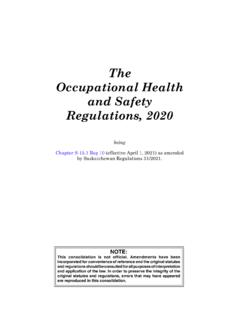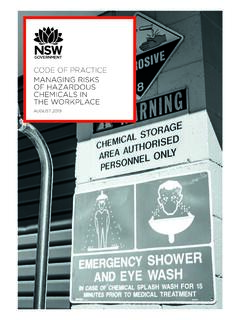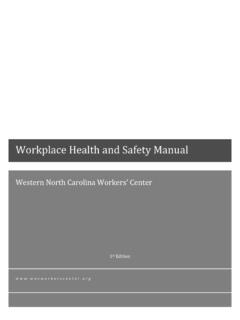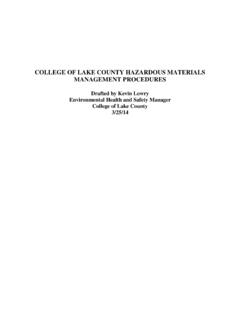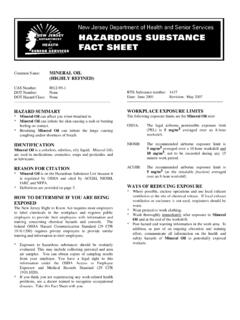Transcription of Steps to an Effective Hazard Communication Program for …
1 FactSheetSteps to an Effective Hazard Communication Program for Employers That Use hazardous ChemicalsEmployers that have hazardous chemicals in their workplaces are required by OSHA s Hazard Communication Standard (HCS), 29 CFR , to implement a Hazard Communication Program . The Program must include labels on containers of hazardous chemicals, safety data sheets (SDSs) for hazardous chemicals, and training for workers. Each employer must also describe in a written Program how it will meet the requirements of the HCS in each of these can implement an Effective Hazard Communication Program by following these six Steps :Step 1. Learn the Standard/Identify Responsible Staff Obtain a copy of OSHA s Hazard Communication Standard. Become familiar with its provisions. Make sure that someone has primary responsibility for coordinating implementation. Identify staff for particular activities ( , training).
2 You may obtain a copy of the Hazard Communication Standard on OSHA s Hazard Communication webpage at The provisions of the standard that apply to employers using chemicals in their workplaces are found primarily in paragraphs (e) written Hazard Communication Program ; (f) labels and other forms of warning; (g) safety data sheets; and (h) employee information and training. It is important that you become familiar with these provisions to determine what is needed for compliance in your order to ensure that you have an Effective Hazard Communication Program , and address all of the necessary components, responsibility for implementation of Hazard Communication should be assigned to someone to coordinate. The person designated for overall Program coordination should then identify staff to be responsible for particular activities, such as 2. Prepare and Implement a Written Hazard Communication Program Prepare a written plan to indicate how Hazard Communication will be addressed in your facility.
3 Prepare a list or inventory of all hazardous chemicals in the (e) of the standard requires employers to prepare and implement a written Hazard Communication Program . This requirement is to help ensure that compliance with the standard is done in a systematic way, and that all elements are coordinated. The written Program must indicate how you will address the requirements of paragraphs (f) labels and other forms of warning; (g) safety data sheets; and (h) employee information and training, in your written Program also requires employers to maintain a list of the hazardous chemicals known to be present in the workplace . Using the product identifier ( , product name, common name, or chemical name) to prepare the list will make it easier for you to track the status of SDSs and labels of a particular hazardous chemical. Remember, the product identifier must be the same name that appears on the label and SDS of the hazardous chemical.
4 Step 3. Ensure Containers are Labeled Keep labels on shipped containers. Label workplace containers where manufacturers and importers are required to provide labels on shipped containers with the following information : product identifier, signal word, pictograms, Hazard statements, precautionary statements, and the name, address and phone number of the responsible party. Therefore, when an employer receives a hazardous chemical from a supplier, all of this information will be located together on the label; however, additional information may also appear. As the employer, you are required to ensure that containers in the workplace are labeled. You may use the same label from the supplier or you may label workplace containers with alternatives, such as third party systems ( , National Fire Protection Association (NFPA) or hazardous Materials Identification System (HMIS)) in addition to the other required information .
5 Any container of hazardous chemicals in the workplace must at a minimum include the product identifier and general information concerning the hazards of the chemical. Whatever method you choose, your workers need to have access to the complete Hazard information . Step 4. Maintain Safety Data Sheets (SDSs) Maintain safety data sheets for each hazardous chemical in the workplace . Ensure that safety data sheets are readily accessible to data sheets are the source of detailed information on a particular hazardous chemical. Employers must maintain copies of SDSs for all hazardous chemicals present in their workplaces. If you do not receive an SDS from your supplier automatically, you must request one. You also must ensure that SDSs are readily accessible to workers when they are in their work areas during their work shifts. This accessibility may be accomplished in many different ways. You must decide what is appropriate for your particular workplace .
6 Some employers keep the SDSs in a binder in a central location ( , outside of the safety office, in the pick-up truck on a construction site). Others, particularly in workplaces with large numbers of chemicals, provide access electronically. However, if SDSs are supplied electronically, there must be an adequate back-up system in place in the event of a power outage, equipment failure, or other emergency involving the primary electronic system. In addition, the employer must ensure that workers are trained on how to use the system to access SDSs and are able to obtain hard copies of the SDSs. In the event of a medical emergency, hard copy SDSs must be immediately available to medical personnel. Step 5. Inform and Train Employees Train employees on the hazardous chemicals in their work area before initial assignment, and when new hazards are introduced. Include the requirements of the standard, hazards of chemicals, appropriate protective measures, and where and how to obtain additional (h) of the HCS requires that employers train employees on the hazardous chemicals in their work area before their initial assignment and when new hazards are introduced into the work area, and this training must be conducted in a manner and language that employees can understand.
7 Workers must understand they are exposed to hazardous chemicals. They must know that labels and safety data sheets can provide them with information on the hazards of a chemical, and these items should be consulted when needed. In addition, workers must have a general understanding of what information is provided on labels and SDSs, and how to access them. They must also be aware of the protective measures available in their workplace , how to use or implement these measures, and whom they should contact if an issue arises. DSG FS-3696 03/2014 This is one in a series of informational fact sheets highlighting OSHA programs, policies or standards. It does not impose any new compliance requirements. For a comprehensive list of compliance requirements of OSHA standards or regulations, refer to Title 29 of the Code of Federal Regulations. This information will be made available to sensory-impaired individuals upon request.
8 The voice phone is (202) 693-1999; teletypewriter (TTY) number: (877) 6. Evaluate and Reassess Your Program Review your Hazard Communication Program periodically to make sure that it is still working and meeting its objectives. Revise your Program as appropriate to address changed conditions in the workplace ( , new chemicals, new hazards , etc.).Although the HCS does not require you to evaluate and reassess your Hazard Communication Program , it must remain current and relevant for you and your employees. The best way to achieve that is to review your Hazard Communication Program periodically to make sure that it is still working and meeting its objectives and to revise it as appropriate to address changed conditions in the workplace ( , new chemicals, new hazards , etc.).Additional information See Hazard Communication : Small Entity Compliance Guide for Employers That Use hazardous Chemicals for more detailed information on how to implement an Effective Hazard Communication Program .
9 Additional information on the Hazard Communication Standard can be found on OSHA s Hazard Communication webpage at










